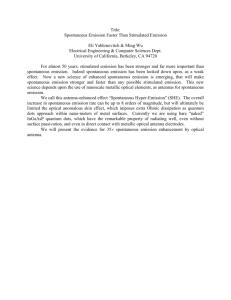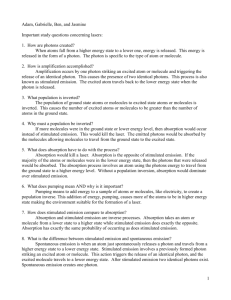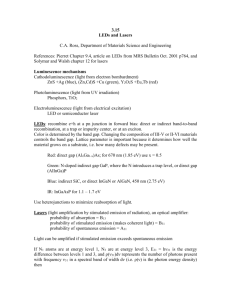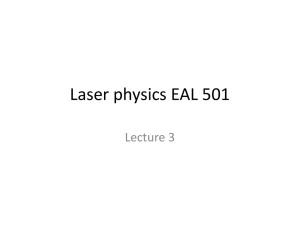and then they return to a lower energy level by spontaneous emission.
advertisement
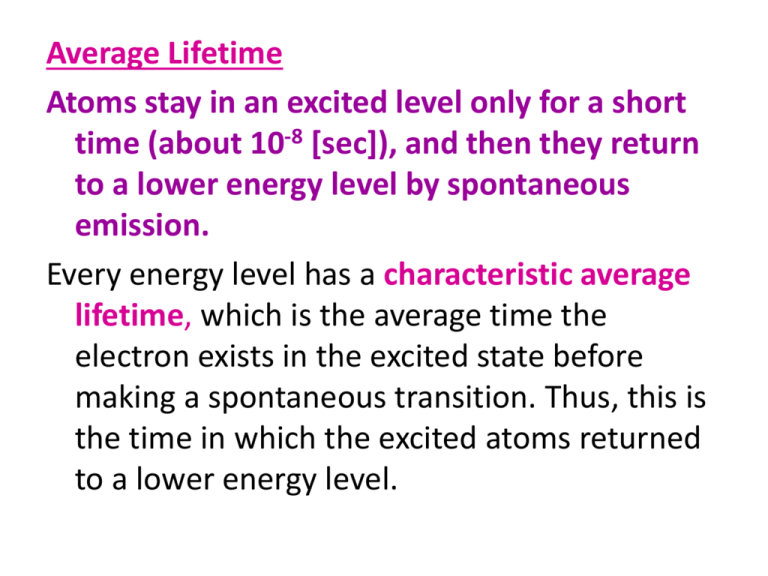
Average Lifetime Atoms stay in an excited level only for a short time (about 10-8 [sec]), and then they return to a lower energy level by spontaneous emission. Every energy level has a characteristic average lifetime, which is the average time the electron exists in the excited state before making a spontaneous transition. Thus, this is the time in which the excited atoms returned to a lower energy level. • According to the quantum theory, the transition from one energy level to another is described by statistical probability. • The probability of transition from higher energy level to a lower one is inversely proportional to the lifetime of the higher energy level. • In reality, the probability for different transitions is a characteristic of each transition, according to selection rules. • When the transition probability is low for a specific transition, the lifetime of this energy level is longer (about 10-3 [sec]), and this level becomes a "metastable" level. In this meta-stable level a large population of atoms can assembled. As we shall see, this level can be a candidate for lasing process. • When the population number of a higher energy level is bigger than the population number of a lower energy level, a condition of "population inversion" is established. • If a population inversion exists between two energy levels, the probability is high that an incoming photon will stimulate an excited atom to return to a lower state, while emitting another photon of light. • The probability for this process depend on the match between the energy of the incoming photon and the energy difference between these two levels The Einstein Relation • To introduce probabilities for these emission and absorption phenomena, let Ni be the number of atoms (or molecules) per unit volume that at time t occupy a given energy level, Ni • For the case of spontaneous emission, the probability that the process occurs is defined by stating that the rate of decay of the upper state population (dN2/dt)sp must be proportional to the population N2. We can therefore write 1.2 the minus sign accounts for the fact that the time derivative is negative • The coefficient A, introduced in this way, is a positive constant called the rate of spontaneous emission or the Einstein A coefficient. • The quantity τsp = 1/A is the spontaneous emission (or radiative) lifetime. Similarly, for nonradiative decay, we can generally write 1.3 τnr is the nonradiative decay lifetime, depends only on the particular transition considered. For nonradiative decay, on the other hand, τnr depends not only on the transition but also on characteristics of the surrounding medium. For stimulated emission we can write 1.4 (dN2/dt)st is the rate at which transitions 2→ 1 occur as a result of stimulated emission and W21 is the rate of stimulated emission. the coefficient W21 also has the dimension of (time)-1 Unlike A, however, W21 depends not only on the particular transition but also on the intensity of the incident em wave. More precisely, for a plane wave, we can write 1.5 F is the photon flux of the wave and σ21 is a quantity having the dimension of an area (the stimulated emission cross section) and depending on characteristics of the given transition. we can define an absorption rate W21 using the equation: 1.6 where (dN1/dt)a is the rate of transitions l→2 due to absorption and N1 is the population of level 1. 1.7 where σ12 is some characteristic area (the absorption cross section), which depends only on the particular transition. It can be given in general farm: 1.7a • Function g(ν — νo), symmetric about ν = ν 0, again of unit area, i.e., such that ʃg(ν — νo)dν = 1, and generally given by: Einstein showed that for nondegenerate energy levels, has W21 = W12 and thus σ21 = σ12 If levels 1 and 2 are g1-fold and g2-fold degenerate (quantum physics describes a system in which different quantum states have equal energy), respectively, one then has , The corresponding expression for the absorption or simulated rate W= σF can then be written as: ρ =(nFhv/c) is the energy density of the em wave and μ is the electric dipole moment. also we can write • stimulated emission, and absorption can be described in terms of absorbed or emitted photons as follows a) In the spontaneous emission process, the atom decays from level 2 to level 1 through the emission of a photon, b) In the stimulated emission process, the incident photon stimulates the transition 2→ 1, so that there are two photons (the stimulating one and the stimulated one), c) In the absorption process, the incident photon is simply absorbed to produce transition 1→2. Thus each stimulated emission process creates a photon, whereas each absorption process annihilates a photon. Einstein Thermodynamic Treatment In Einstein treatment the concept of stimulated emission was first clearly established, and the correct relationship between spontaneous and stimulated transition rates was derived well before the formulation of quantum mechanics and quantum electrodynamics. Let us assume that the material is placed in a blackbody cavity whose walls are kept at a constant temperature T. Once thermodynamic equilibrium is reached, an em energy density with a spectral distribution ρv given by Plank Eq. 1.10 is established and the material is immersed in this radiation. • In this material, both stimulated emission and absorption processes occur in addition to the spontaneous emission process. • Since the system is in thermodynamic equilibrium, the number of transitions per second from level 1 to level 2 must be equal to the number of transitions from level 2 to level 1. We now set , • Where W21 stimulation rate of transition from level 2 to 1,W12 absorption rate of transition from level1to2, B21 the Einstein stimulation coefficients, B12 the Einstein absorption coefficients. Let Ne1 and Ne2 be the equilibrium populations of levels 1 and 2, respectively. We can then write 1.12 • From Boltzmann statistics we also know that, for nondegenerate levels: 1.13 Using eq. 1.1.12 and 1.1.13.in eq. 1.1.10 we get 1.14 When ν=νo we get the following relations: 1.15 , 1.16 This equations show the relation between Einstein coefficients it can be measured laboratory for any element. Integration of this equation with the assumption that gt(v — v0) can be approximated by a Dirac δ function in comparison with ρv (see Fig. 2.3), we obtain 1.17 • A comparison between Eqs. (1.1.11a) and (1.1.11b) or (1.1.17) then gives 1.18, 1.19 Plot of the function ρv(v, T) as a function of frequency v at two values of temperature T. • We can therefore write for the expression: 1.20 The normalized function [g(ν — νo)∆νo] is plotted in Fig. 2.6 versus the normalized frequency difference (ν — νo)/(∆vo/2). The full width of the curve between the two points having half the maximum value [full width at half-maximum (FWHM)] is simply ∆v0. The symbol gt(v - v0) for the total lineshape function, which can be expressed as: Using Fourier analysis to obtain line profile, where gt is a function give the probability of this excitation transition. Emission line is described by plotting spontaneous emission radiation intensity as a function of frequency (or wavelength), for the specific lasing transition. • A curve of the general form described by Eq. is referred to as Lorentzian after H. E. Lorentz fig 2.6, who first derived it in his theory of the electron oscillator. A curve of the general form described by Eq. is referred to as Gaussian fig 2.8 • The ratio for the spontaneous emission to the stimulated emission can be written as • Example: • Calculate the ratio of spontaneous emission to stimulated emission for a tungsten filament operating at a temperature of 2000K taking the average frequency to be 5x1014Hz. • Solution • The ratio R = exp[(6.6x10-34*4x1014)/(1.38x10-23*2000)] • By neglecting the flux density, R = 1.5x105 • This confirms that under normal condition of thermal equilibrium stimulated emission is not an important process

